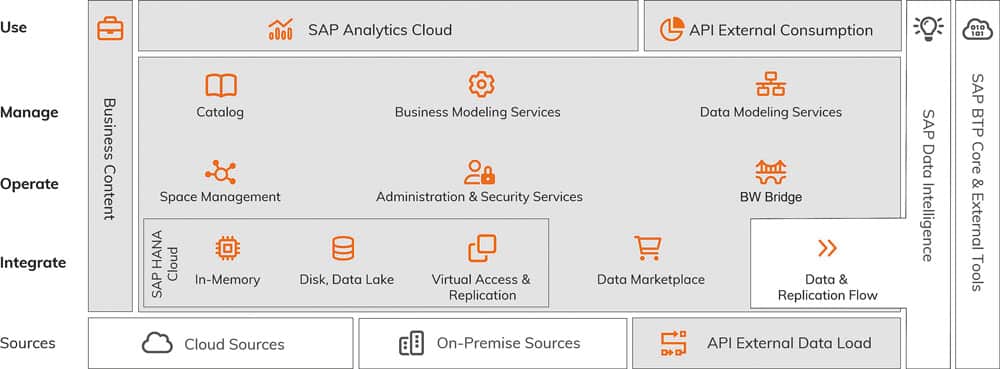Freedom for data and analysis


SAP has replaced the Data Warehouse Cloud with Datasphere
The task is as old as IT itself: How can user companies use their data economically? And regardless of when and where they were generated and stored with which application? Experienced SAP users remember a whole series of attempts by the provider to help its customers do this. However, without much success, as experts have noted time and again.
Accordingly, many experts reacted with restraint when SAP presented Datasphere in the spring of 2023. As part of the virtual event "SAP Data Unleashed", Datasphere was presented as "a unified solution for data integration, data cataloging, semantic modeling, data warehousing, data federation and data virtualization". The solution is said to enable data professionals to "easily distribute business-critical data across the entire data landscape while maintaining business context and logic." This presentation might give the impression of a "general-purpose tool" and thus exaggerate expectations. But more on that later.
First, the good news: SAP has recognized the unresolved challenge of simple interaction with corporate data from different sources. In its product strategy, the Walldorf-based company is now unifying the entire range of functionalities for data management and analytics in an overall concept, so that in the future customers will be able to put together the services they need entirely according to their needs. The launch of the Datasphere continues the previous development of the data warehouse cloud architecture in the direction of the so-called Business Data Fabric. This is an integrated, semantically versatile data layer for end-to-end access to data in all areas of an organization's data landscape.

At the same time, users receive information on the business context and logic required to generate added value from data. What is new about this is above all the fact that it has actually become easier to use SAP and non-SAP data in an integrated way. For example, this technology allows data from Oracle data warehouse to be combined with data from a BW/4 Hana. This is an important step in the right direction, because the previous efforts for extracting, transforming and restoring data have prevented many a successful innovation of data-based business models.
Data in focus
From the user's point of view, the greatest benefit of the current innovations of the Datasphere lies in the focus on the data - and not on the technology or its manufacturers. This is all the more true because it didn't stop at a vision. Rather, Datasphere brings a range of concrete new capabilities for discovering, modeling and distributing mission-critical business data. Among their highlights is the Datasphere Analytic Model. This enables data experts to solve complex modeling requirements by reusing semantic definitions from SAP applications.
New multidimensional modeling capabilities with comprehensive analytical approaches support both business and IT users when it comes to developing productively usable models for the business more quickly. For example, tables for purchase requisitions and materials can be combined into an analytical model that provides key users with information for optimizing the flow of materials. This does not require a technical understanding of the processes in the background of the data warehouse that are mapped by Datasphere.
If data-based business models are to work, it is essential to minimize manual data management to the maximum. An important tool in this context is the Datasphere Catalog. It helps to find, manage and control data automatically. This also simplifies compliance with data governance rules throughout the entire data lifecycle. In addition, Datasphere includes numerous tools and technologies that help companies bring all their data together and ensure that all stakeholders are always working with the same data.
Simplified data landscape
More and more data inevitably leads to more and more complexity, as the number of possible relationships between individual data sets increases progressively with the amount of data. This makes the need for simple, secure and flexible handling of the infrastructure for managing these rapidly growing data volumes all the greater. SAP Datasphere therefore runs in any cloud and in hybrid environments. This enables location-independent access to all company data. In addition, existing on-prem customers of the SAP Business Warehouse (BW) will be able to use their data in Datasphere in the future.
With BW Bridge, a special service from Datasphere for integrating inventory data into BW, NetWeaver BW and BW/4 users get transfer tools to move their existing data models and connectors to the public cloud. Once integrated, the data can then be combined and provisioned into virtual workspaces using Datasphere Spaces. These virtual workspaces are particularly suited to data consumers who frequently access specific data constellations, such as marketing, sales, suppliers, partners, and AI teams.
Entry into the Datasphere is particularly easy for companies that are already data warehouse cloud customers: They automatically receive the new functionalities as additional services in their existing cloud interface, completely without migration.
Datasphere not a universal tool
The announcement quoted at the beginning could give the impression of a universal tool for all data-related applications. This makes it all the more important to keep in mind what Datasphere is at its core: a data management layer that serves to make data available for a wide variety of applications. The aim here is not to slay all possible problems with one solution. Rather, the Datasphere is deliberately designed to be so open that users can decide for themselves which tasks they process with which tools. Finally, SAP offers further solutions in the area of data and analytics with the SAP Analytics Cloud and the SAP Data Intelligence Cloud. Both are components of the SAP Business Technology Platform (BTP) - like Datasphere. When it comes to generating economic value from data, the interaction between these components and, if necessary, other applications from different providers is required.
Economic benefit
The interaction between the various components for data and analytics can be demonstrated using the following scenario as an example: A company that places advertising in soccer stadiums needs to report to its customers how often and how long their logo or advertising motif was visible during the TV broadcast of a soccer match. To do this, it uses an AI-based image recognition service from the cloud that analyzes the streaming data of the TV broadcast.
Depending on the customer's specifications, the service provides a more or less detailed list of the times when the motif was visible. This structured data is transferred from the respective service provider to Datasphere via an SAP Open Connector. From here, it travels directly to the customer for their reporting and internally to the marketer's ERP system for billing to the customer. The unstructured video data, on the other hand, is transferred to the Analytics Cloud, where it is used for further analysis. For example, a data-based customer recommendation could be made for a different positioning of his motif.
In another scenario, a machine manufacturer wants to evaluate the energy requirements of its production lines in detail. The goal is to save costs, produce more sustainably, and efficiently provide data for CSR reporting. The aim is to combine and evaluate streaming data from different sources. Thus, the data first runs into the Data Intelligence Cloud, from where it is transferred to the Analytics Cloud after automated integration and orchestration.
With the help of machine learning and other AI technologies, forecasts and simulations of future energy requirements are generated here. In parallel, the actual data is transferred to the Datasphere, where it can be accessed at any time from anywhere for various reports and further calculations.
These two woodcut-like examples alone show: In conjunction with SAP Analytics Cloud and Data Intelligence Cloud, Datasphere gives companies plenty of room to freely design their data-related workflows - depending on the tasks and objectives they are pursuing. The challenge remains to make the best possible use of this freedom.







